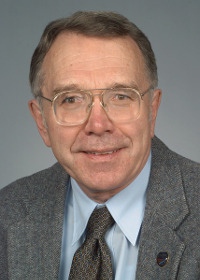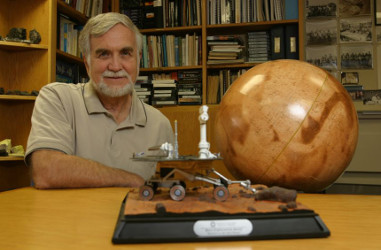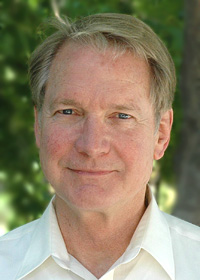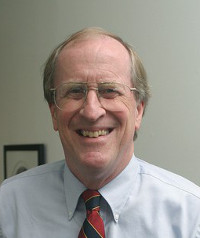Joseph Veverka – 2013 Gerard P. Kuiper Prize
 The Division for Planetary Sciences of the American Astronomical Society is pleased to award the 2013 Gerard P. Kuiper Prize for outstanding contribution to planetary science to Joseph Veverka.
The Division for Planetary Sciences of the American Astronomical Society is pleased to award the 2013 Gerard P. Kuiper Prize for outstanding contribution to planetary science to Joseph Veverka.
Dr. Joseph Veverka is a professor Emeritus at Cornell University and the former James A. Weeks Professor of Physical Sciences and Professor of Astronomy. He received his bachelor’s and master’s degrees from Queen’s University in Kingston, Ontario in 1965, and master’s and doctoral degrees from Harvard University in Cambridge, Massachusetts in 1970. Dr. Veverka is a fellow of the American Geophysical Union, and a fellow of the American Association for the Advancement of Science, and he served as Chair of the American Astronomical Society Division for Planetary Sciences in 1985 and 1986. Among his many achievements, he was also editor of Icarus from 1982 to 1983 and from 1989 to 1990.
Dr. Joseph Veverka has made outstanding contributions to the field of planetary science during a career that now spans five decades. Joe has to his credit a lifetime of outstanding contributions, that, in sum, represent a monumental increase in our understanding of planets and, in particular, small bodies – the moons, asteroids and cometary nuclei in our planetary system. As a planetary scientist, Joe has defined the field of quantitative study of small bodies in the Solar System for a generation (a generation populated by his students and many associates). Beginning with his thesis work, Joe has been associated with the understanding of light scattering from planetary surfaces, from the moons of Mars to asteroids to icy satellites to comets. With his students and research associates, Joe founded the school of photometric analysis that joins the elegance of Bruce Hapke’s theoretical scattering calculations with practical observational quantities measurable from spacecraft.
At the beginning of his career, Joe’s exceptional scientific achievements included incisive analyses of ground-based telescopic occultation data and of photometric data of planetary surfaces. Following this were exceptional contributions in developing the observations for, and analyzing the results from, the Mariner 9, Viking, Mars Observer, and Mars Global Surveyor explorations of Phobos, Deimos, and other Martian phenomena. In parallel with these works he acted as Deputy Team leader of the Galileo Imaging Science Team, playing a major role in directing the exploration of Gaspra and Ida and the small moons and rings of Jupiter, then as the Principal Science Investigator in the NEAR mission exploration of the asteroids Mathilde and Eros. Joe also played a vital role in the exploration of many outer solar system objects as a member of the Voyager and Cassini imaging teams, and as a leader in the exploration of comet nuclei on the Deep Impact and Stardust-NExT mission explorations of comet 9P/Tempel 1 and the EPOXI mission to comet 103P/Hartley 2.
Joe’s research has helped to bring attention to the importance of small bodies in providing clues to the processes that formed our solar system. He played a leading role in the early studies of Phobos and Deimos and coordinated the efforts to obtain the first close-up images of an asteroid (951 Gaspra). Joe was instrumental in advancing the field of photometry as a means of characterizing the composition and texture of planetary surfaces. His contributions to the geologic study of satellites, asteroids, and comets are extensive. He has also conducted research on planetary ring systems and Titan’s atmosphere. His bibliography demonstrates his profound influence on the field and includes over 300 peer-reviewed publications.
In addition, through exceptional service to the community, Joe has also found time to shape many aspects of the United States program of robotic Solar System Exploration as we know it today. Joe was instrumental in getting NASA to accept and act on the concept of Principal Investigator (PI) led, moderately low cost missions. Such missions constitute an important scientific capability and when funding is limited, they are the only way to acquire new data from spacecraft. Joe has also made numerous, major contributions to the community through his leadership on 24 NASA advisory groups, also chairing many panels for NASA, including Science Working Groups for missions going back to 1978. Most recently, Joe chaired the Small Bodies Panel of the National Academy of Science’s second Decadal Survey of planetary science.
While a professor at Cornell, Joe has mentored and provided a formative influence on his students and research associates. Many of his thesis advisees have gone on to highly successful careers in planetary science, including Bonnie Buratti, Jay Goguen, Steve Lee, Linda French, Steve Squyres, Damon Simonelli, Pascal Lee, Anne Verbiscer, and Peter Thomas.
Joe has had a lifelong love of operatic music and he reads endlessly on the topic of American History. Teddy Roosevelt is his favorite historical character and author. Joe likes to hunt and go fishing in his spare time. He is also extremely handy with a chainsaw, and he collects stamps from around the world.
In his work with NASA advisory groups, Joe’s colleagues count on him to steer efforts away from unfruitful directions and toward the most productive goals. Let’s not waste any more time in recognizing our own – Dr. Joe Veverka.
Anders Johansen – 2013 Harold C. Urey Prize
 The Division for Planetary Sciences of the American Astronomical Society is pleased to award the 2013 Harold C. Urey Prize for outstanding achievement in planetary research by a young scientist to Anders Johansen.
The Division for Planetary Sciences of the American Astronomical Society is pleased to award the 2013 Harold C. Urey Prize for outstanding achievement in planetary research by a young scientist to Anders Johansen.
Dr. Johansen is currently Associate Senior Lecturer at the University of Lund in Sweden. His work on planetesimal accretion and more recently on giant planet core formation has provoked paradigm shifts in a field which for years had been plagued by long-standing problems.
The classical view of planetesimal accretion from accumulation of smaller particles faces the so-called “meter-size barrier problem”. While dust growth proceeds smoothly up to 1 m-size or so, larger planetesimals are thought to undergo high-velocity disruptive collisions, preventing further accretion. Dr. Johansen proposed an alternative scenario where 10-cm to 1 m boulders, or even smaller pebbles, are concentrated by gas drag in local vortices. Occasionally the concentration of pebbles and boulders is large enough that clumps can form, remain bound and collapse by self-gravity, leading directly to the formation of 100- to 1000-km diameter planetesimals, bypassing the meter-size barrier. By quantitative exploring several instability mechanisms, including the so-called “streaming instability”, he showed the formation of self-gravitating clumps to be effective and robust. Not only did his model change the paradigm in planetesimal formation, but by predicting that planetesimals form big, it also provides an explanation to the “elbow” at 100 km in the asteroid-size distribution.
More recently, Anders Johansen addressed another long-standing problem, the formation of the large solid cores of the giant planets. Ample meteoritic evidence shows that planetesimal formation was a prolonged process, with much solid material remaining in small particles even at a late stage. Johansen showed that once formed, planetesimals continue to capture sub-meter-size pebbles. Because the accretion rate is highly sensitive to planetesimal mass, the process leads to the formation of a few large Earth-mass cores at the detriment of many smaller planetesimals. Essentially, planetesimals smaller than Ceres in the asteroid belt and Pluto in the Kuiper Belt remained small bodies, while the larger ones became planetary embryos and participated into Giant Planet formation.
By filling not one but two major gaps in one of the most difficult area of solar system studies, Dr. Johansen’s findings represent one of the most significant contributions to the field since the pioneering works of Safronov and Wetherill. His achievements have been the combined result of imagination, technical skill, and a deep knowledge of diverse relevant fields, ranging from hydro-dynamical simulations to meteorite cosmochemistry. For his impressive achievements, the Division for Planetary Sciences is proud to award the 2013 Harold C. Urey Prize to Anders Johansen.
Ronald Greeley – 2013 Harold Masursky Award
 The Division for Planetary Sciences of the American Astronomical Society presents the 2013 Harold Masursky Award for outstanding service to planetary science and exploration to Ronald Greeley.
The Division for Planetary Sciences of the American Astronomical Society presents the 2013 Harold Masursky Award for outstanding service to planetary science and exploration to Ronald Greeley.
Ron Greeley was a Regents’ Professor of Planetary Geology at Arizona State University until his death on Oct. 27, 2011. He was one of the founders of the field of planetary geology and early on recognized that understanding the processes and histories of solar system bodies required integration of field, laboratory, modeling, and observational studies. Ron received his PhD in Geology in 1966 from the University of Missouri at Rolla. Through service in the US Army, he was assigned to NASA’s Ames Research Center in 1967, where he trained astronauts and helped prepare for the Apollo missions to the Moon. After his military service ended, he remained at NASA Ames to conduct research in planetary geology. Ron joined the faculty at Arizona State University in 1977 with a joint professorship in the Department of Geology and the Center for Meteorite Studies. His research focused on volcanic and aeolian processes on Earth and other planetary bodies. He also was a specialist in geologic mapping from planetary images, being the lead author on numerous maps of the solar system’s planets and satellites.
Ron served as the founding director of the NASA-ASU Regional Planetary Image Facility and Principle Investigator of the Planetary Aeolian Laboratory at NASA Ames. He served on and chaired many NASA and National Academy of Sciences definition teams and study groups to assess space science and planetary geology activities. Among the panels he chaired were the NASA Planetary Geology and Geophysics Management Operations Working Group, the National Academy of Sciences Committee on Planetary and Lunar Exploration, and the NASA Mars Exploration Program Analysis Group. He convened numerous workshops and field conferences and served as associate editor for Journal of Geophysical Research, Icarus, and Astrobiology as well as the Cambridge University Press Planetary Science Series.
Ron was involved in nearly every major space probe mission flown in the solar system since the Apollo missions to the Moon. Mission projects included the Galileo mission to Jupiter, Magellan mission to Venus, Voyager 2 mission to Uranus and Neptune, and Shuttle Imaging Radar orbiter around Earth. Passionate about Mars exploration, Ron was involved with several missions to the Red Planet, including Mariners 6, 7, and 9, Viking, Mars Pathfinder, Mars Global Surveyor, and the Mars Exploration Rovers. He was a co-investigator for the High Resolution Stereo Camera on the European Mars Express mission.
Ron’s final projects included service as the chair of the Planetary Science Subcommittee of the NASA Advisory Council and co-chair of various Science Definition Teams for Europa Orbiter mission concepts. His work lives on in his former students and colleagues who work and teach in the planetary sciences and who today play pivotal roles in space science efforts.
In recognition of his life-long service to the field of planetary science, the Division for Planetary Sciences is pleased to present posthumously the 2013 Harold Masursky Award for Meritorious Service to Dr. Ronald Greeley.
Donald K. Yeomans – Carl Sagan Medal
 The Division for Planetary Sciences of the American Astronomical Society awards the 2013 Carl Sagan Medal for excellence in public communication to Donald Yeomans.
The Division for Planetary Sciences of the American Astronomical Society awards the 2013 Carl Sagan Medal for excellence in public communication to Donald Yeomans.
The inevitability of collisions between asteroids and the Earth is a topic that naturally engages public interest. Ever more systematic searches have turned up an increasing number of “near-misses” or objects with statistically small, but non-zero probabilities of a future impact within the uncertainties of existing observations. The urgency of these events is amplified by actual impacts such as the Chelyabinsk bolide in February, 2013. For more than two decades, Don Yeomans has been the “go to” person whenever the media seek a planetary scientist to illuminate the scientific middle ground between the hype and the ho-hum.
Don has capitalized on his roles as manager of the NASA NEO Program Office at JPL and a co-I on the Deep Impact mission to build a lengthy resume of media appearances, outreach events, and popular press contributions. His calm demeanor and scientific rigor have helped to dampen doomsday hysteria and sound the all-clear on more serious potential risks (e.g. Apophis) when improved observations warrant. And in every case he takes the opportunity to educate the public on the real long-term risks and potential benefits of Near Earth Objects.
Don is a prolific author with more than 160 professional publications, and numerous writings in the popular press. He has authored five books, most recently his 2012 work, “NEOS: Finding Them Before They Find Us”.
Don’s recognized expertise has led to multiple invitations, not only to the general public but also to testify to Congressional representatives and staff. In February 2013 he testified for NASA to the United Nations Committee on the Peaceful Uses of Outer Space only days after the dramatic Chelyabinsk bolide shook the world to attention. In recognition of the importance of Don’s role, he was recently named one of the 100 Most Influential People in the world by TIME magazine.
Donald Yeomans embodies the spirit of communication and public engagement that the Sagan medal was intended to honor and that the DPS is happy to bestow.
Richard A. Kerr – 2013 Jonathan Eberhart Planetary Sciences Journalism Award
 Dr. Richard A. Kerr is a journalist who has spent his entire professional career covering Earth and planetary science news for Science magazine. His audience: more than 100,000 world-class experts in science — but not necessarily expert in the kind of science he writes about. It’s a challenging beat, because his readers are knowledgeable, savvy, and skeptical. Since science papers often come with a backstory that he frequently reviews in his articles, he must analyze and critique the quality of the work on its own merits and put it into context for the field. Kerr wrote in A Field Guide for Science Writers: “If, as veteran San Francisco Chronicle science reporter David Perlman once wrote, science writing is a continuing graduate education, then writing for scientists is a Ph.D. in science news reporting.”
Dr. Richard A. Kerr is a journalist who has spent his entire professional career covering Earth and planetary science news for Science magazine. His audience: more than 100,000 world-class experts in science — but not necessarily expert in the kind of science he writes about. It’s a challenging beat, because his readers are knowledgeable, savvy, and skeptical. Since science papers often come with a backstory that he frequently reviews in his articles, he must analyze and critique the quality of the work on its own merits and put it into context for the field. Kerr wrote in A Field Guide for Science Writers: “If, as veteran San Francisco Chronicle science reporter David Perlman once wrote, science writing is a continuing graduate education, then writing for scientists is a Ph.D. in science news reporting.”
Kerr originally planned to be a meteorologist, but found calculus an obstacle, and ended up studying chemistry at the College of Wooster. Following two deployments in the navy during the Vietnam War, he did his Ph.D. in oceanography at the University of Rhode Island. While at URI, he “surreptitiously” took two night classes in magazine story writing and news reporting — his entire formal training in journalism. A fellow student told him about the job opening as a writer for Science magazine, where he was hired one week after defending his dissertation, and where he has been ever since, 36 years.
Many of us have had the pleasure of answering Kerr’s knowledgeable, incisive questions, but he is able to ask intelligent questions of fields ranging from asteroids striking Earth to weather on Mars. Kerr’s education has continued throughout his career, through exhaustive reading of publications, bulletins, and abstract volumes, and through attendance of Earth and planetary science conferences. Kerr has an enviable skill for picking newsworthy stories out of voluminous abstract volumes, and for injecting a carefully calibrated quantity of skepticism into his reports on the most sensational discoveries.
Kerr’s exceptional service to science journalism has been well recognized in the past. He was the recipient of a Special Award from the American Meteorological Society for the “consistently high quality of his articles in Science in 1990; AGU’s first Award for Sustained Achievement in Science Journalism in 1993; the James Shea Award from the National Association of Geology Teachers in 1994 for “excellence in geoscience writing”; American Geological Institute’s award for Outstanding Contribution to Public Understanding of Geology in 1995; Fellow of Geological Society of America in 1995; Distinguished Public Service Award from Geological Society of America in 2006; and the Distinguished Achievement Award from University of Rhode Island in 2009.
A testament to his unflagging effort to promote planetary sciences though Science is the 2012 article titled “Peering Inside the Moon to Read its Earliest History.” The article focuses on the violent impact history of our Moon as observed by the GRAIL mission. For this engaging and stimulating article, the Division for Planetary Sciences is pleased to present the 2013 Jonathan Eberhart Planetary Sciences Journalism Award to Dr. Richard A. Kerr.
